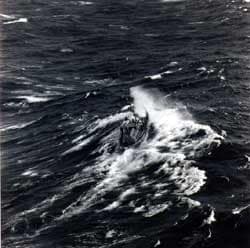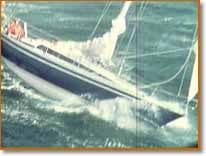As I write this 300 or so yachts have raced out of the Solent into the English Channel and are heading towards Lands End in this year’s Fastnet race. This year, the media’s attention has focused mostly on the 30th anniversary of the tragic 1979 Fastnet Race.
 It is well covered on Yachting Monthly’s web site and as Captain JP blogged it was featured on UK’s Channel 4 News in a candid interview with two of the survivors of the ill-fated Grimalkin. This is most dramatic as one the two survivors was abandoned for dead by the rest of the crew.
It is well covered on Yachting Monthly’s web site and as Captain JP blogged it was featured on UK’s Channel 4 News in a candid interview with two of the survivors of the ill-fated Grimalkin. This is most dramatic as one the two survivors was abandoned for dead by the rest of the crew.
The best account of the tragedy is John Rousmaniere’s excellent Fastnet Force 10. It’s been 15 years since I first read it and it was well-worth returning to it. The stories of loss are heart-breaking and the accounts of rescues are inspiring. The facts are terrifying for any sailor: Out of 303 entrants, 194 retired, 19 boats were abandoned and five sank. Most tragic of all was the loss of life – Fifteen died, including four on the American boat Ariadne.
The weather, was forecasted to hit Force 8. Tough conditions but within the range of anyone racing in the Fastnet. As storms sometimes do across Britain and Ireland, this storm worsened rapidly. It increased to Force 10, hitting Force 12 in some locations. The worst of weather hit most of the fleet in the worst possible place at the worst possible time, in the Channel approaches or close to Fastnet Rock. Too far from land to head for a safe port before the storm hit and even then, the parts of the coast of Ireland or Southwestern Britain that were reachable were notoriously dangerous.
According to the race inquiry, 70 per cent of the entrants faced Force 11 or above with winds of 55 knot or more and waves of 30 feet or more. Many faced waves of more than 40 feet. Close to half the boats reported a knock-down to horizontal or almost horizontal, a third reported that their boat rolled beyond horizontal. Most terrible of all, one eighth of the fleet were capsized entirely and dismasted. Several began to sink as the washboards had fallen out on the roll and every massive wave filled the boat faster than the crews could bail.
or more and waves of 30 feet or more. Many faced waves of more than 40 feet. Close to half the boats reported a knock-down to horizontal or almost horizontal, a third reported that their boat rolled beyond horizontal. Most terrible of all, one eighth of the fleet were capsized entirely and dismasted. Several began to sink as the washboards had fallen out on the roll and every massive wave filled the boat faster than the crews could bail.
The disaster raised many questions about the circumstances of the race. Should it have been canceled? Could so much devastation have been avoided? Were the boats adequately equipped or big enough? Were the skippers and their crew experienced enough? These questions were aimed squarely at the race organizer, RORC, the Royal Ocean Racing Club.
RORC’s secretary, Alan Green held daily press-conferences to satisfy the baying hounds of the British media who were pretty biased in their assessment that the “toffs” who ran the Fastnet Race had acted recklessly.
In one encounter, Green was repeatedly asked why the race was not canceled when they heard the storm warnings. Green’s response:
“The way the sport is organized, it is the skipper’s responsibility to decide whether to race or not.”
His response may have seemed like a callous shirking of responsibilities. Rousmaniere is analytical and objective in his assessment. He spoke from first-hand experience as he was in the race on the American yacht, Toscana. On balance, he put it down to a nightmare convergence of circumstance.
 Was it the size and design of the boats? When you look at the statistics from the race, all the deaths and all but one abandonment occurred on boats of less than 38 feet. That said, the longer boats sailed faster and the majority had sailed beyond the worst of the weather. The worst of the weather focused on the smaller, slower boats. Boat size is not an adequate reason enough.
Was it the size and design of the boats? When you look at the statistics from the race, all the deaths and all but one abandonment occurred on boats of less than 38 feet. That said, the longer boats sailed faster and the majority had sailed beyond the worst of the weather. The worst of the weather focused on the smaller, slower boats. Boat size is not an adequate reason enough.
Was it the experience of the crew? The vast majority of the skippers had sailed in long offshore races and there was little difference in the degree of severe damage encountered by less or more experienced skippers. The majority of skippers reported in the inquiry that the steep breaking seas were the worst they had ever accounted and they struggled even with proven storm tactics in those conditions. Undoubtedly experience helped but the storm was at the limits of anyone’s capability.
Could the conditions have been forecasted better? Maybe, but bear in mind that this was 30 years ago and even now weather is incredibly hard to predict accurately. Even as recently as 1998, weather caused a major sailing disaster when 6 died and 5 boats sank during the Sydney-Hobart Race that year. The dilemma in the 1979 Fastnet Race was that the forecasted Force 8 was within the capability of all who were racing. Had the race been canceled on the available information, RORC would have faced a mutiny by the entrants. By the time it was clear that conditions would be significantly worse, it was hard for RORC to do much. This was made worse by the fact that weather updates were only broadcast every six hours. As Rousmaniere points out, had the storm happened a week later, it would barely been noticed. It was just incredibly unlucky that it hit when and where it did.
In retrospect, Green’s words ring true. It is the skipper’s responsibility to make decisions based on the available information about the weather, their boat and crew.
One of my aspirations is to do some serious offshore racing. Re-reading Rousmaniere’s book got me to ask myself some big questions. If I was crewing, how would I know if the skipper was adequately prepared and the boat was up to it? If I wanted to skipper, would I have a boat that could cope with extreme conditions and sail fast enough to win? Would I be experienced enough to deal with the conditions? Would I have what it takes to lead the crew in this kind of adversity? If something happens to me, could my crew cope? What would I do if faced with the decisions that the skippers of Grimalkin, Ariadne, Trophy and the other boats who fared the worst during Fast 1979?
As my sailing is limited to daysailing, short cruises and racing in the Bay, it’s easy to be casual about being a skipper. Even then the safety of the crew is paramount. Re-reading Fastnet Force 10, hit home to me that when you take a crew offshore, the responsibility on the skipper, level of experience required, expectations of the boat and crew are exponentially higher.

I dare say in those conditions I’d be in Stage 2 seasickness, which is when you’re afraid you’re *not* going to die.